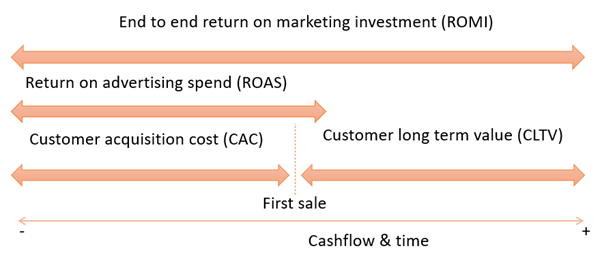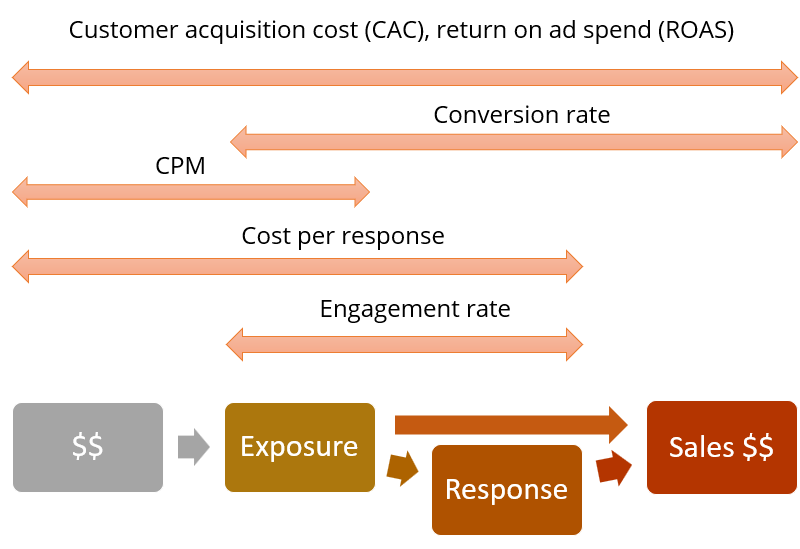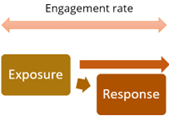The key measure that determines viability of your marketing efforts is Return on Marketing Investment (ROMI):

A positive ROMI means marketing pays for itself and can continue indefinitely. According to a study by Thinkbox, the benchmark value for ROMI is 3, meaning that, on average, a marketing campaign generates a profit four times the investment.
This profit, however, has two distinct parts:

Short-term (gross) profit is directly linked to marketing activity. For example, when you attract customers via search ads, the sale can be directly attributed to the ads the customer clicked on. Techniques also exist to credit sales increases to offline advertising in aggregate when individual sales cannot be tracked.
Short-term benefits of advertising are often described by Return on Ad Spend (ROAS):

Various sources cite benchmark ROAS values between 4 and 10.
Long-term profit includes repeat business from previously acquired customers, increased brand awareness and reputation, and advocacy from existing customers. At the time of analysis, these components cannot yet be directly observed, but heuristic methodologies can project them into the future.
Despite its uncertain nature, when we talk about marketing as an investment, it is the long-term profit that works as the investment return. This profit persists after the marketing campaign has finished and gradually fades over months to years.
Ignoring brand awareness and reputation enhancements for the moment, another way of looking at ROMI is through the customer acquisition process:

This introduces two important metrics:
The diagram below shows how ROMI, ROAS, CAC, and CLTV collectively describe marketing returns:

This perspective views campaign success as the ability to attract high-quality customers, thereby increasing CLTV, and doing so in large quantities per dollar invested, thus reducing CAC.
Let’s look inside the customer acquisition process. The diagram below shows the process for all media except search engine marketing (a high-intent channel):

This process works in three steps:
There are three key metrics for exposure:
Impressions are important because media is mostly sold on the basis of cost per thousand impressions (CPM or cost-per-mille). Reach and frequency are important because they determine the size of the audience that had a reasonable chance to see and engage with your ads. A good media buyer, assisted by media optimization tools, will achieve the required reach and frequency with a minimal number of impressions.
Impressions and reach-and-frequency are reported either by the digital platforms or through independent panel-based measurement (both TV and digital). InContekst uses these metrics to calculate overall marketing effectiveness.
Media channels have limited reach, and when you buy more impressions in a short time frame, you eventually stop reaching new people, causing your ads to be repeated to the same audience. This unproductive repetition wastes your advertising budget and is known as channel saturation. InContekst calculates this parameter when assessing campaign performance.

If you have a website, people will visit it. If you have a call center, they might call it. The engagement rate measures the share of people who engaged with your business (e.g., visiting your website or calling your call center) out of the audience exposed to the advertising. This is measured by correlating increases in website visits, brand name searches, or call center calls with advertising activity.
While not everyone who will end up buying your product will visit your website first, the engagement rate provides an immediate (hours to days) measure of how well your audience receives your advertising message. In digital display media (excluding high-intent search engine searches), this is a better indicator than click-through rate, which has a non-existent to negative correlation with sales according to this study.
InContekst can calculate your engagement rate, as well as the cost-per-response/cost-per-website visit rate about a week into your campaign, giving you enough time to optimize it.

This metric tells you whether the offer/pricing/product is right for your target audience. Unlike CAC, the conversion rate excludes the cost of exposure, which can be influenced by factors such as ever-growing media costs. Unlike the engagement rate, which looks only at people who expressed their interest, the conversion rate considers all customers. While the engagement rate is an immediate metric, the conversion rate can only be measured with some delay (e.g., weekly), as interested people might wait for the weekend (or longer) to act on their interest.